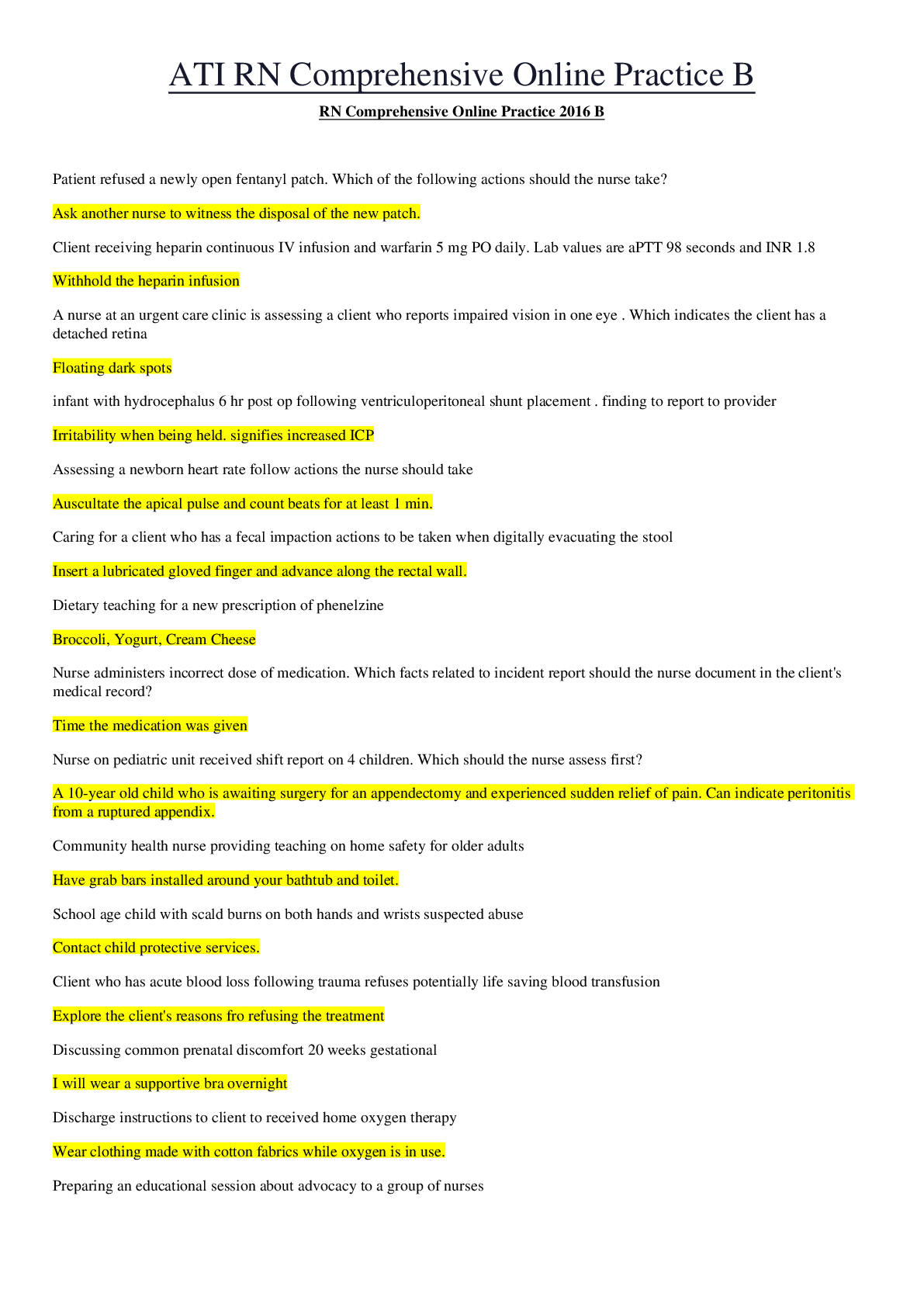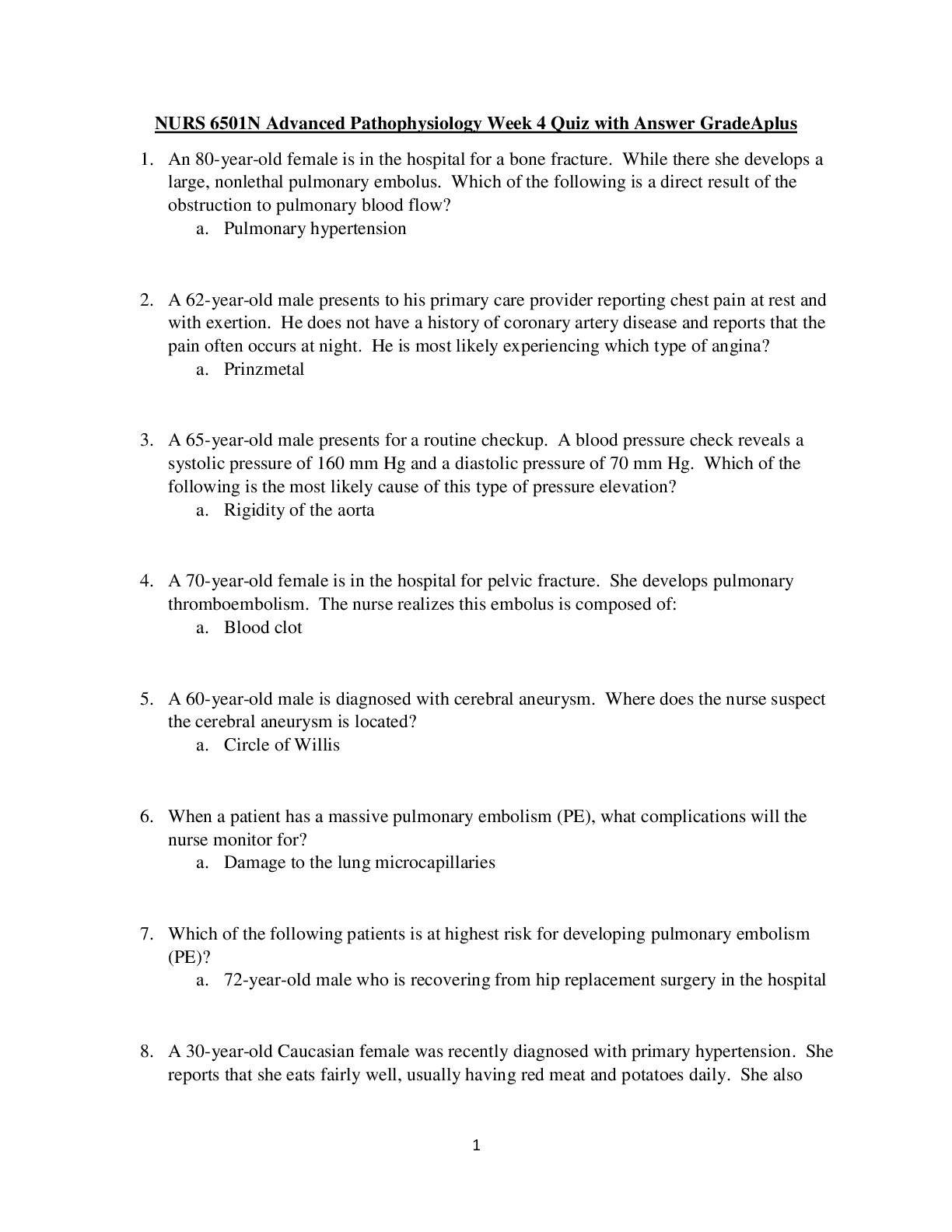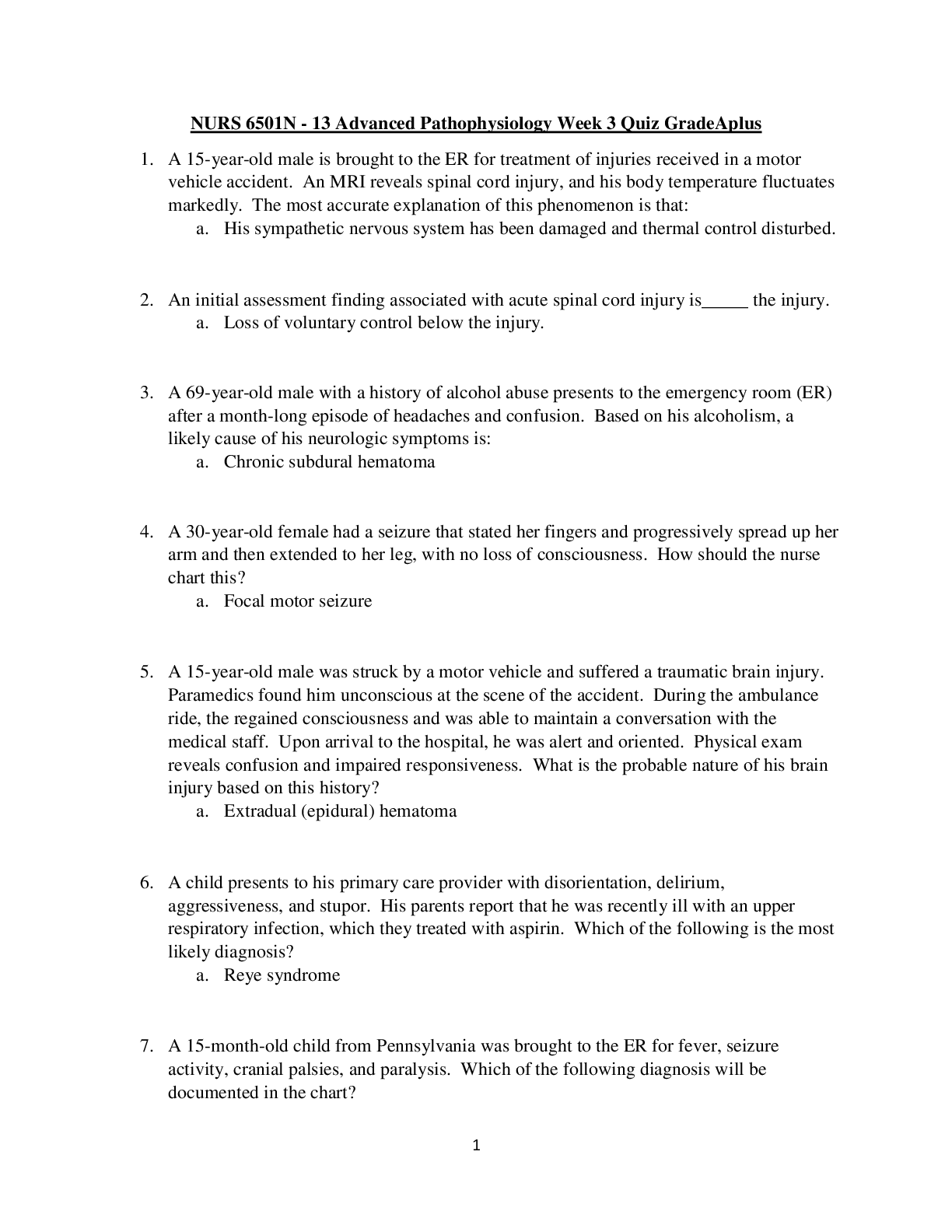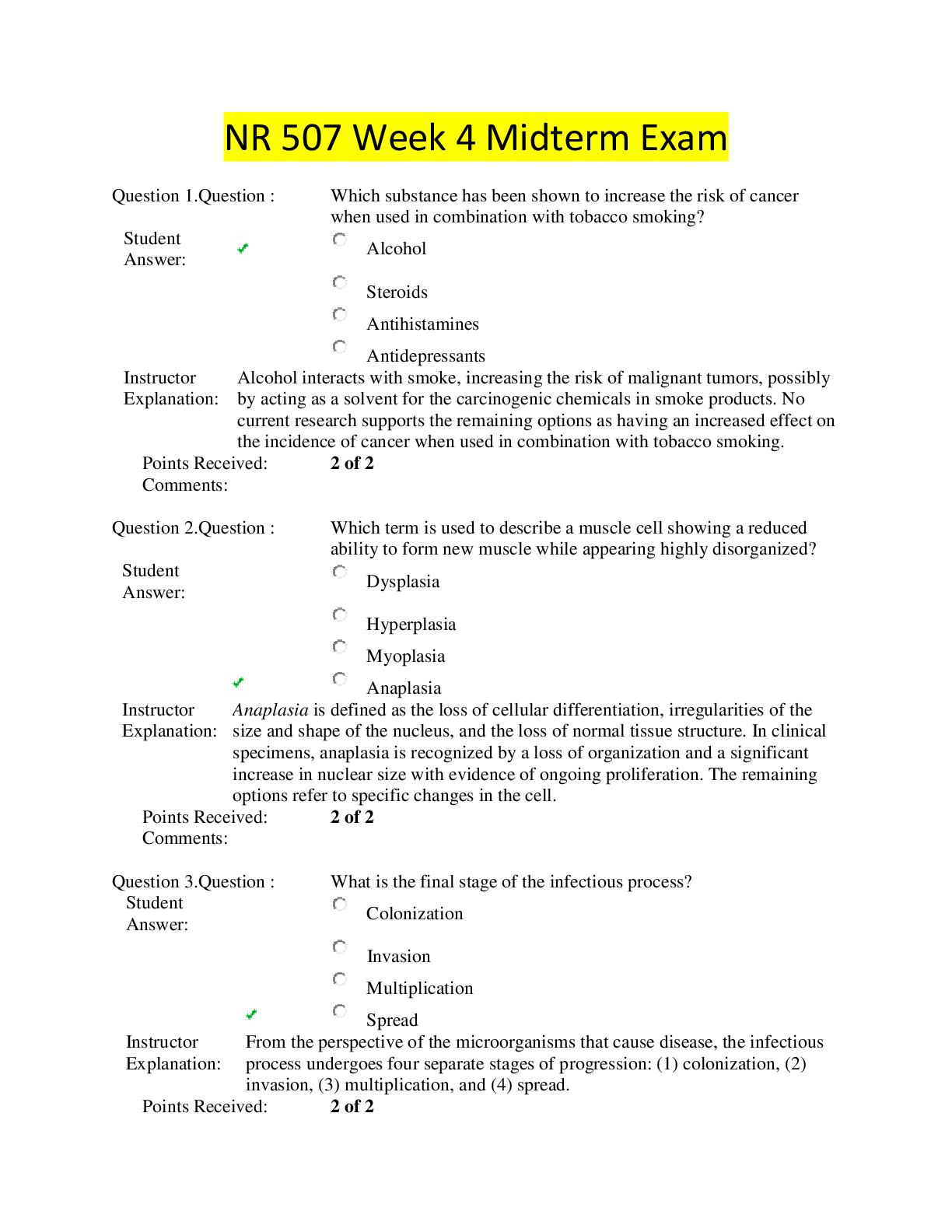Pathophysiology > EXAM > NR 507 Advanced Pathophysiology Week 2 Quiz_2020 | NR507 Advanced Pathophysiology Week 2 Quiz_Graded (All)
NR 507 Advanced Pathophysiology Week 2 Quiz_2020 | NR507 Advanced Pathophysiology Week 2 Quiz_Graded A
Document Content and Description Below
Advanced Pathophysiology Week 2 Quiz Question 1 2 / 2 pts Which are indications of dehydration? Correct! Tachycardia and weight loss Decreased hemoglobin and hematocrit Muscle w... eakness and decreased deep tendon reflexes Polyuria and hyperventilation Marked water deficit is manifested by symptoms of dehydration: headache, thirst, dry skin and mucous membranes, elevated temperature, weight loss, and decreased or concentrated urine (with the exception of diabetes insipidus). Skin turgor may be normal or decreased. Symptoms of hypovolemia, including tachycardia, weak pulses, and postural hypotension, may be present. Question 2 2 / 2 pts At the arterial end of capillaries, fluid moves from the intravascular space into the interstitial space because the interstitial hydrostatic pressure is higher than the capillary hydrostatic pressure. capillary oncotic pressure is lower than the interstitial hydrostatic pressure. interstitial oncotic pressure is higher than the interstitial hydrostatic pressure. Correct! capillary hydrostatic pressure is higher than the capillary oncotic pressure. At the arterial end of capillaries, fluid moves from the intravascular space into the interstitial, because capillary hydrostatic pressure is higher than the capillary oncotic pressure. Question 3 2 / 2 pts Which enzyme is secreted by the juxtaglomerular cells of the kidney when circulating blood volume is reduced? Angiotensin II Aldosterone Angiotensin I Correct! Renin When circulating blood volume or blood pressure is reduced, renin, an enzyme secreted by the juxtaglomerular cells of the kidney, is released in response to sympathetic nerve stimulation and decreased perfusion of the renal vasculature. Question 4 2 / 2 pts In hyperkalemia, cardiac rhythm changes are a direct result of Correct Answer cardiac cell hypopolarization. cardiac cell repolarization. You Answered cardiac cell hyperexcitability. depression of the sinoatrial (SA) node. If extracellular potassium concentration increases without a significant change in intracellular potassium, the resting membrane potential becomes more positive (i.e., changes from –90 to –80 mV) and the cell membrane is hypopolarized (the inside of the cell becomes less negative or partially depolarized [increase excitability]). (Electrical properties of cells are discussed in Chapter 1.) Question 5 2 / 2 pts Why are infants susceptible to significant losses in total body water (TBW)? Because they are unable communicate adequately when they are thirsty Because more than half of an infant’s body weight is water Correct! Because an infant’s kidneys are not mature enough to counter fluids losses Because infants have a slow metabolic rate Infants are particularly susceptible to significant changes in TBW because of their high metabolic rate and the accelerated turnover of body fluids caused by their greater body surface area in proportion to total body size. Loss of fluids from diarrhea can represent a significant proportion of body weight. Renal mechanisms that regulate fluid and electrolyte conservation may not be mature enough to counter the losses, so dehydration may develop rapidly. Question 6 2 / 2 pts Physiologic pH is maintained around 7.4 because bicarbonate (HCO3) and carbonic acid (H2CO3) exist in a ratio of 1:20. Correct! 20:1. 10:5. 10:2. The relationship between bicarbonate and carbonic acid is usually expressed as a ratio. When the pH is 7.40, this ratio is 20:1 (bicarbonate/carbonic acid). Question 7 2 / 2 pts How does the loss of chloride during vomiting cause metabolic alkalosis? Loss of chloride causes hydrogen to move into the cell and exchange with potassium to maintain cation balance. Correct! Loss of chloride causes retention of bicarbonate to maintain the anion balance. Loss of chloride causes hypoventilation to compensate for the metabolic alkalosis. Loss of chloride stimulates the release of aldosterone, which causes the retained sodium to bind with the chloride. When acid loss is caused by vomiting with depletion of ECF and chloride (hypochloremic metabolic alkalosis), renal compensation is not very effective because the volume depletion and loss of electrolytes (Na+, K+, H+, Cl-) stimulate a paradoxical response by the kidneys. The kidneys increase sodium and bicarbonate reabsorption with excretion of hydrogen. Bicarbonate is reabsorbed to maintain an anionic balance because the ECF chloride concentration is decreased. Question 8 2 / 2 pts Which of the following is a true statement? Hyperventilation results in an increased PaCO2. Correct! Hyperventilation causes hypocapnia. Hyperventilation causes hypercapnia. Hypoventilation causes hypocapnia. Hyperventilation is alveolar ventilation that exceeds metabolic demands. The lungs remove CO2 at a faster rate than it is produced by cellular metabolism, resulting in decreased PaCO2 or hypocapnia. Question 9 2 / 2 pts _____ is a fulminant form of respiratory failure characterized by acute lung inflammation and diffuse alveolocapillary injury. Acute pulmonary edema Pneumonia Correct! Acute respiratory distress syndrome (ARDS) Pulmonary emboli ARDS is a fulminant form of respiratory failure characterized by acute lung inflammation and diffuse alveolocapillary injury. Question 10 2 / 2 pts Clinical manifestations that include unexplained weight loss, dyspnea on exertion, use of accessory muscles, and tachypnea with prolonged expiration are indicative of Correct! emphysema. asthma. pneumonia. chronic bronchitis. Individuals with emphysema usually have dyspnea on exertion that later progresses to marked dyspnea, even at rest (Table 33-3). Little coughing and very little sputum are produced. The individual often is thin, has tachypnea with prolonged expiration, and must use accessory muscles for ventilation. The anteroposterior diameter of the chest is increased (barrel chest), and the chest has a hyperresonant sound with percussion. Question 11 2 / 2 pts Which inflammatory mediators are produced in asthma? Correct! Histamine, prostaglandins, and leukotrienes Bradykinin, serotonin, and neutrophil proteases Neutrophil proteases, bradykinin, and histamine Lymphokines, serotonin, and prostaglandins A large number of inflammatory mediators, such as histamine, prostaglandins, and leukotrienes are produced by asthma. Question 12 2 / 2 pts A(n) _____ is a circumscribed area of suppuration and destruction of lung parenchyma. empyema consolidation Correct! abscess cavitation An abscess is a circumscribed area of suppuration and destruction of lung parenchyma. Question 13 2 / 2 pts Which pleural abnormality involves a site of pleural rupture that act as a one-way valve, permitting air to enter on inspiration but preventing its escape by closing during expiration? Correct! Tension pneumothorax Secondary pneumothorax Open pneumothorax Spontaneous pneumothorax In tension pneumothorax, the site of pleural rupture acts as a one-way valve, permitting air to enter on inspiration but preventing its escape by closing up during expiration. As more and more air enters the pleural space, air pressure in the pneumothorax begins to exceed barometric pressure. Question 14 2 / 2 pts Kussmaul respirations may be characterized as a respiratory pattern commonly observed in chronic obstructive pulmonary disease. Correct! with a slightly increased ventilatory rate, large tidal volumes, and no expiratory pause. commonly observed in pulmonary fibrosis. with alternating periods of deep and shallow breathing. Kussmaul respirations are characterized by a slightly increased ventilatory rate, very large tidal volume, and no expiratory pause. Question 15 2 / 2 pts High altitudes may produce hypoxemia through shunting. Correct! decreased inspired oxygen. [Show More]
Last updated: 2 years ago
Preview 1 out of 7 pages

Buy this document to get the full access instantly
Instant Download Access after purchase
Buy NowInstant download
We Accept:

Reviews( 0 )
$12.50
Can't find what you want? Try our AI powered Search
Document information
Connected school, study & course
About the document
Uploaded On
Mar 06, 2021
Number of pages
7
Written in
Additional information
This document has been written for:
Uploaded
Mar 06, 2021
Downloads
0
Views
67








 – University of the People.png)

















